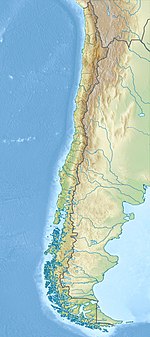| Farellones Formation | |
|---|---|
| Stratigraphic range: Miocene | |
| Type | Geologic formation |
| Sub-units | Upper member Lower member |
| Overlies | Abanico Formation |
| Thickness | >3,000 m (9,800 ft) |
| Lithology | |
| Primary | Rhyolitic ignimbrite, rhyolitic tuff, andesitic lava, basaltic lava |
| Other | Breccia |
| Location | |
| Coordinates | 33°21′3″S 70°18′50″W / 33.35083°S 70.31389°W |
| Region | Valparaíso Region Santiago Metropolitan Region O'Higgins Region |
| Country | |
| Extent | Central Andes |
| Type section | |
| Named for | Farellones |
| Named by | Klohn |
| Year defined | 1960 |
Farellones Formation (Spanish: Formación Farellones) is a geological formation of Miocene age in the Andes of Central Chile made up almost entirely of volcanic and volcaniclastic rocks. At some location reaches thicknesses in excess of 3,000 metres (9,800 ft).[1] It overlies the Oligo–Miocene Abanico Formation across a diachronous unconformity.[1] The best exposure of the formation is said to be at the ski resort of Farellones east of Santiago.[2]
- ^ a b Godoy, Estanislao (2012). "Sobre el variable marco geotectónico de las formarciones Abanico y Farellones y sus equivalentes al ser de los 35°LS". Revista de la Asociación Geológica Argentina (in Spanish). 69 (4): 570–577. Retrieved 30 December 2015.
- ^ Vergara, Mario; Drake, Robert (1979). "Edades K/ar en secuencias volcánicas continentales postneocomianas de Chile Central; su depositación en cuencas intermontanas restringidas". Revista de la Asociación Geológica Argentina (in Spanish). XXXIV (1): 42–52.
